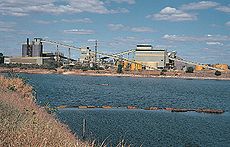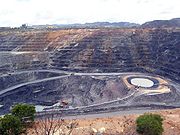
Uranium mining debate
Encyclopedia


Nuclear power
Nuclear power is the use of sustained nuclear fission to generate heat and electricity. Nuclear power plants provide about 6% of the world's energy and 13–14% of the world's electricity, with the U.S., France, and Japan together accounting for about 50% of nuclear generated electricity...
or nuclear weapons.
Background
As of 2009, in terms of uranium production, KazakhstanKazakhstan
Kazakhstan , officially the Republic of Kazakhstan, is a transcontinental country in Central Asia and Eastern Europe. Ranked as the ninth largest country in the world, it is also the world's largest landlocked country; its territory of is greater than Western Europe...
was the largest supplier to export markets (27%), followed by Canada
Uranium mining in Canada
For many years, Canada was the largest exporter of uranium ore in the world and has been a major world producer since demand for uranium developed. In 2009 Kazakhstan took over top spot, relegating Canada to second. 20% of the world's primary uranium production came from mines in Canada in 2009. ...
(20%) and Australia
Uranium mining in Australia
Radioactive ores were first extracted at Radium Hill in 1906, and Mount Painter in South Australia in the 1930s, to recover radium for medical use. Several hundred kilograms of uranium were also produced....
(16%). Australia has 23% of the world's uranium ore reserves and the world's largest single uranium deposit, located at the Olympic Dam
Olympic Dam, South Australia
Olympic Dam is a mining centre in South Australia located some 550 km NNW of Adelaide, the capital city of South Australia. It is the site of an extremely large iron oxide copper gold deposit producing copper, uranium, gold and silver. The site hosts an underground mine as well as an...
Mine in South Australia
South Australia
South Australia is a state of Australia in the southern central part of the country. It covers some of the most arid parts of the continent; with a total land area of , it is the fourth largest of Australia's six states and two territories.South Australia shares borders with all of the mainland...
.
The years 1976 and 1977 saw uranium mining
Uranium mining
Uranium mining is the process of extraction of uranium ore from the ground. The worldwide production of uranium in 2009 amounted to 50,572 tonnes, of which 27% was mined in Kazakhstan. Kazakhstan, Canada, and Australia are the top three producers and together account for 63% of world uranium...
become a major political issue in Australia, with the Ranger Inquiry (Fox) report
Russell Walter Fox
Russell Walter Fox AC QC LLB is an Australian author, educator, jurist and former chief judge of the Supreme Court of the Australian Capital Territory. He is best known for his extensive report on uranium mining in Australia in the early 1980s....
opening up a public debate about uranium mining. The Movement Against Uranium Mining group was formed in 1976, and many protests and demonstrations against uranium mining were held. Concerns relate to the health risks and environmental damage
Uranium in the environment
Uranium in the environment refers to the science of the sources, environmental behaviour, and effects of uranium on humans and other animals. Uranium is weakly radioactive and remains so because of its long physical half-life...
from uranium mining.
In 1977, the Australian Labor Party
Australian Labor Party
The Australian Labor Party is an Australian political party. It has been the governing party of the Commonwealth of Australia since the 2007 federal election. Julia Gillard is the party's federal parliamentary leader and Prime Minister of Australia...
(ALP) national conference passed a motion in favour of an indefinite moratorium on uranium mining, and the anti-nuclear movement in Australia
Anti-nuclear movement in Australia
Nuclear testing, uranium mining and export, and nuclear energy have often been the subject of public debate in Australia, and the anti-nuclear movement in Australia has a long history...
acted to support the Labor Party and help it regain office. However, after the ALP won power in 1983, the 1984 ALP conference voted in favour of a "Three mine policy
Three mine policy
The three mine policy, introduced in 1984 and abandoned in 1996, was a policy of the government of Australia to limit the number of uranium mines in the country to three.-History:...
".
Australia has three operating uranium mines at Olympic Dam (Roxby) and Beverley
Beverley Uranium Mine
The Beverley Mine is Australia's third uranium mine and Australia's first operating in-situ recovery mine. It is located 35 km from Lake Frome at the northern end of the Flinders Ranges in South Australia and opened in 2001...
- both in South Australia
South Australia
South Australia is a state of Australia in the southern central part of the country. It covers some of the most arid parts of the continent; with a total land area of , it is the fourth largest of Australia's six states and two territories.South Australia shares borders with all of the mainland...
's north - and at Ranger
Ranger Uranium Mine
The Ranger uranium mine is surrounded by Kakadu National Park, in the Northern Territory of Australia, 230 km east of Darwin. The orebody was discovered in 1969, and the mine commenced operation in 1980, reaching full production of uranium oxide in 1981...
in the Northern Territory. As of April 2009, construction has begun on South Australia's third uranium mine—the Honeymoon Uranium Mine
Honeymoon Uranium Mine
The Honeymoon Mine will be Australia's fourth uranium mine and Australia's second operating in-situ recovery mine. The mine is owned by Uranium One. The uranium deposit belongs to the palaeochannel type.-See also:* Uranium mining in Australia...
.
Notable anti-uranium activists include Kevin Buzzacott
Kevin Buzzacott
Kevin Buzzacott , often referred to as Uncle Kev as an Aboriginal elder, is an Indigenous Australian from the Arabunna nation in northern South Australia...
(Australia), Jacqui Katona
Jacqui Katona
Jacqui Katona is a western-educated Aboriginal woman who led the campaign to stop the Jabiluka uranium mine in the Northern Territory. In 1998 the Mirrar Aboriginal people, together with environmental groups, used peaceful on-site civil disobedience to create one of the largest blockades in...
(Australia), Yvonne Margarula
Yvonne Margarula
Yvonne Margarula won the 1998 Friends of the Earth International Environment Award and the 1998 Nuclear-Free Future Award. She also won the 1999 U.S...
(Australia), Jillian Marsh
Jillian Marsh
Jillian Marsh was raised in the coal-mining town of Leigh Creek, in South Australia’s Flinders Ranges, and she has had a long interest in mining issues and indigenous communities. In 1998 Marsh received the prestigious Jill Hudson Environmental Award for her work in educating people living near the...
(Australia), Manuel Pino
Manuel Pino
Manuel Pino is a professor at Scottsdale Community College in Arizona, who comes from a village of the Tewa people west of Albuquerque, New Mexico. Opposition to uranium mining has played a central role in Pino's life. The theme for his sociology dissertation was The Destructive Impact of Uranium...
(USA), JoAnn Tall
JoAnn Tall
JoAnn Tall is an environmental activist of the Oglala Lakota tribe who has worked to ensure the people have a chance to approve major projects for energy development...
(USA), and Sun Xiaodi
Sun Xiaodi
Sun Xiaodi has spent more than a decade petitioning the central Chinese authorities over radioactive contamination from the No. 792 Uranium Mine in the Gannan Tibetan Autonomous Prefecture in Gansu Province. In 2006, he received the prestigious Nuclear-Free Future Award.-External links:*...
(China).
Health risks of uranium mining
Because uranium ore emits radonRadon
Radon is a chemical element with symbol Rn and atomic number 86. It is a radioactive, colorless, odorless, tasteless noble gas, occurring naturally as the decay product of uranium or thorium. Its most stable isotope, 222Rn, has a half-life of 3.8 days...
gas, uranium mining can be more dangerous than other underground mining, unless adequate ventilation systems are installed. During the 1950s, many Navajos
Navajo Nation
The Navajo Nation is a semi-autonomous Native American-governed territory covering , occupying all of northeastern Arizona, the southeastern portion of Utah, and northwestern New Mexico...
in the U.S. became uranium miners, as many uranium deposits were discovered on Navajo reservations
Indian reservation
An American Indian reservation is an area of land managed by a Native American tribe under the United States Department of the Interior's Bureau of Indian Affairs...
. A statistically significant subset of these early miners later developed small cell carcinoma
Small cell carcinoma
Small cell carcinoma is a type of highly malignant cancer that most commonly arises within the lung, although it can occasionally arise in other body sites, such as the cervix and prostate....
after exposure to uranium ore. Radon
Radon
Radon is a chemical element with symbol Rn and atomic number 86. It is a radioactive, colorless, odorless, tasteless noble gas, occurring naturally as the decay product of uranium or thorium. Its most stable isotope, 222Rn, has a half-life of 3.8 days...
-222, a natural decay product
Decay product
In nuclear physics, a decay product is the remaining nuclide left over from radioactive decay. Radioactive decay often involves a sequence of steps...
of uranium, has been shown to be the cancer-causing agent. Some American survivors and their descendants received compensation under the Radiation Exposure Compensation Act
Radiation Exposure Compensation Act
The United States Radiation Exposure Compensation Act is a federal statute providing for the monetary compensation of people, including atomic veterans, who contracted cancer and a number of other specified diseases as a direct result of their exposure to atmospheric nuclear testing undertaken by...
in 1990.
In January 2008 Areva
Areva
AREVA is a French public multinational industrial conglomerate headquartered in the Tour Areva in Courbevoie, Paris. AREVA is mainly known for nuclear power; it also has interests in other energy projects. It was created on 3 September 2001, by the merger of Framatome , Cogema and...
was nominated for an Anti Oscar Award. The French state-owned company mines uranium in northern Niger where mine workers are not informed about health risks, and analysis shows radioactive contamination of air, water and soil. The local organization that represents the mine workers, spoke of "suspicious deaths among the workers, caused by radioactive dust and contaminated groundwater."
See also
- Nuclear power debateNuclear power debateThe nuclear power debate is about the controversy which has surrounded the deployment and use of nuclear fission reactors to generate electricity from nuclear fuel for civilian purposes...
- Nuclear weapons debateNuclear weapons debateThe nuclear weapons debate is about public controversies relating to the use and stockpiling of nuclear weapons. Even before the first nuclear weapons had been developed, scientists involved with the Manhattan Project were divided over the use of the weapon. The Little Boy atomic bomb was detonated...
- The Return of Navajo BoyThe Return of Navajo BoyThe Return of Navajo Boy is an award-winning documentary film produced by Jeff Spitz and Bennie Klain about the Cly family, Navajo who have suffered health problems due to environmental contamination from uranium mining on tribal land in Monument Valley, Utah...
- Church Rock uranium mill spillChurch Rock Uranium Mill SpillThe Church Rock Uranium Mill Spill occurred in New Mexico, USA, in 1979 when United Nuclear Corporation's Church Rock uranium mill tailings disposal pond breached its dam. Over 1,000 tons of radioactive mill waste and millions of gallons of mine effluent flowed into the Puerco River, and...
- Uranium mining and the Navajo peopleUranium mining and the Navajo peopleAfter the end of World War II, the United States encouraged uranium mining production because of the nuclear arms race with the U.S.S.R., its opponent in the Cold War. Large uranium deposits were found on and near the Navajo Reservation in the Southwest, and private companies hired many Navajo...

